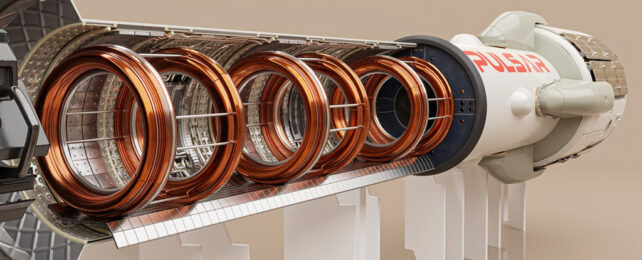Nuclear fusion propulsion technology has the potential to revolutionize space travel in terms of both speeds and fuel usage. The same kinds of reactions that power the Sun could halve travel times to Mars, or make a journey to Saturn and its moons take just two years rather than eight.
It's incredibly exciting, but not everyone is convinced this is going to work: the tech needs ultra-high temperatures and pressures to function.
To help prove the viability of the technology, the largest ever fusion rocket engine is now being built by Pulsar Fusion in Bletchley, in the UK.
The chamber, some 8 meters (26 feet) long, is scheduled to start firing in 2027.
As you might expect, replicating the Sun inside a rocket isn't easy. At the center of nuclear fusion propulsion is an ultra-hot plasma locked inside an electromagnetic field, and scientists are continuing to figure out how to do this in a stable and safe way.
"The difficulty is learning how to hold and confine the super-hot plasma within an electromagnetic field," says James Lambert, CFO of Pulsar Fusion. "The plasma behaves like a weather system in terms of being incredibly hard to predict using conventional techniques."
Machine learning could help make this box of wild weather a little easy to map. Pulsar Fusion has partnered with Princeton Satellite Systems in the US to use supercomputer algorithms to better predict how the plasma is likely to behave, and how it might be more precisely controlled.
If scientists are able to get everything functioning as intended, temperatures of several hundred million degrees will be reached in the chamber, making it hotter than the Sun. The surplus energy released could potentially drive rocket speeds of 500,000 miles (804,672 kilometers) per hour.
The particular type of engine we're talking about here is a Direct Fusion Drive (DFD), in which the charged particles create thrust directly, rather than converting into electricity. It's more efficient than other options, and as it's powered by atomic isotopes, doesn't need a huge fuel payload.
"You've got to ask yourself, can humanity do fusion?" Pulsar Fusion CEO Richard Dinan told TechCrunch. "If we can't, then all of this is irrelevant."
"If we can – and we can – then fusion propulsion is totally inevitable. It's irresistible to the human evolution of space."
As well as making round trips to planets much shorter, nuclear fusion also promises to provide almost unlimited, clean energy for life here on Earth.
However, scientists think it'll be demonstrated in space first, where the lack of any atmosphere and the ultra-cold temperatures are more conducive to reactions.
